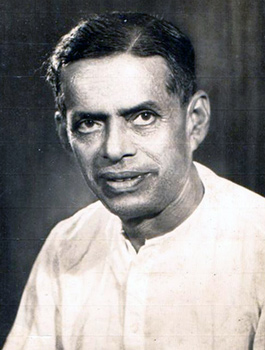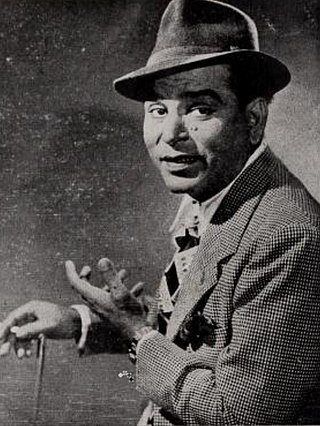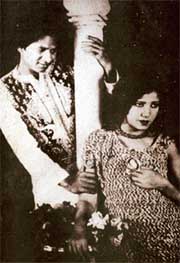
Alam Ara is a 1931 Indian Hindustani-language historical fantasy film directed and produced by Ardeshir Irani. It revolves around a king and his two wives, Navbahaar and Dilbahaar, who are childless; soon, a fakir tells the king that the former wife will give birth to a boy, later named Qamar, but the child will die following his 18th birthday if Navbahaar cannot find the necklace he asks for. Meanwhile, the king finds out that Dilbahaar falls for the senapati Adil, leading the king to arrest him and evicts his pregnant wife, who later gives birth to Alam Ara (Zubeida).

Akkineni Laxmi Vara Prasada Rao, known professionally as L. V. Prasad, was an Indian film director, producer, actor, and businessman. He was one of the pioneers of Indian cinema and is the recipient of the Dadasaheb Phalke Award, the highest Award for films in India. In 1980, he was awarded the Raghupathi Venkaiah Award, for his contribution to Telugu cinema.

Ruby Myers, better known by her stage name Sulochana, was an Indian silent film actress of Jewish ancestry, from the community of Baghdadi Jews in India.

Khan Bahadur Ardeshir Irani was a writer, director, producer, actor, film distributor, film showman and cinematographer in the silent and sound eras of early Indian cinema. He is considered one of the greatest personalities in recent Indian Cinema. He was the director of India's first sound film Alam Ara. He was the producer of India's first colour film Kisan Kanya. He was renowned for making films in Hindi, Telugu, English, German, Indonesian, Persian, Urdu and Tamil. He was a successful entrepreneur who owned film theatres, a gramophone agency, and a car agency.

Ramchandra Gopal Torne, also known as Dadasaheb Torne, was an Indian director and producer, best known for making the first feature film in India, Shree Pundalik. This historic record is well established by an advertisement in The Times of India published on 25 May 1912. Several leading reference books on cinema including The Guinness Book of Movie Facts & Feats, A Pictorial History of Indian Cinema and Marathi Cinema : In Restrospect amply substantiate this milestone achievement of the pioneer Indian feature-filmmaker.

Marathi Cinema, also known as Marathi Chitrapat, is the segment of Indian cinema, dedicated to the production of motion pictures in the Marathi Language widely spoken in the state of Maharashtra. It is based in Mumbai. It is the oldest film industry of India and one of the leader in Filmmaking in India's film industry. The first Marathi talkie film was Ayodhyecha Raja, released in 1932, just one year after Alam Ara the first Hindi talkie, before releasing the Aayodhyecha Raja, all the Marathi films until then were Silent films with Intertitles.

Zubeida Begum Dhanrajgir was an Indian actress. In addition to acting in silent films, she also starred in the first Indian talkie movie Alam Ara (1931). Which was their first talking movie. Her credits include early hits Devdas (1937), and Sagar Movietone's first Natak Meri Jaan.

Prabhat Film Company was an Indian film production company and film studios founded in 1929 by the noted film director V.Shantaram and his friends.

Raja Sandow was an Indian actor, film director and producer. He began his career as an actor in silent films and later became a prominent actor and director in Tamil and Hindi films of the 1930s. He is considered to be one of the pioneers of early Indian cinema.>

Ayodhyecha Raja, literally "The King of Ayodhya", was the first Marathi talkie, released in 1932, directed by Shantaram Rajaram Vankudre. It is based on the puranic story of Raja Harishchandra of Ayodhya and his test by sage Vishwamitra, as recounted in Valmiki's epic, Ramayana.

Kanjibhai Rathod was an Indian film director.

Yakub Khan, known as Yakub, was an Indian actor born into a Pathan family in Jabalpur, Madhya Pradesh, India. He is best known for his comic and comic villainous roles.

Homi Master (?–1949) was an actor-director of early Indian cinema. His work extended from the silent era to the talkie era and up to his death. He produced his best films for Kohinoor Film Company and he has been referred to as "silent cinema's most successful film-maker".

Sagar Movietone also Sagar Films, Sagar Film Company and Sagar Productions was an Indian film production company involved in the making of films for Indian cinema. It was launched by Ardeshir Irani with Chimanlal Desai and Dr. Ambalal Patel in 1929 in Bombay, Maharashtra, India. Sagar was initially started as a branch company of Ardeshir's Imperial Film Company. Several key figures from Imperial, such as Mehboob Khan were shifted to Sagar. The studio was in operation from 1930 to 1939. In 1940, it combined with General Pictures to form National Studios. It made "Parsi theatre based films, mythologicals and stunt movies". Sagar fostered the career of many artists who rose to prominence. Early directors such as Prafulla Ghosh, Sarvottam Badami, Ezra Mir and Nanubhai Vakil were promoted by the company. Mehboob Khan got his first break as a director in Al Hilal in 1935. He was referred to as "the most important alumnus" from Sagar, who went on to become one of Indian cinema's "most influential film-makers".

Mazhar Khan was an actor, producer, and director in Indian Cinema. He began his career as a police officer, which he left to study law for a short period. After abandoning his studies, he came to Bombay and started his career in cinema with the silent film Fatal Garland (1928) opposite the top actress of the time, Ermeline. He became a popular actor, gaining success in several silent films. During his stint in silent films he worked with directors such as Bhagwati Prasad Mishra, Ezra Mir, Moti P. Bhagnani, R. S. Chowdhary, and M. D. Bhavnani. Magazines in the 1940s compared Khan to Hollywood actors such as Paul Muni, Bela Lugosi and Boris Karloff.
Elizer was an Indian actor of Jewish descent.
Iqbal Qureshi was an Indian music composer and director, credited with film scores for several Hindi films between 1958 and 1986, best known for his music to the song "Ek Chameli Ke Mandve Tale" in the film Cha Cha Cha (1964), the first Indian film to feature Western dance.

Sudhabala was an Indian actress from the silent era of Hindi films. She is often credited of giving break to Prithviraj Kapoor, the patriarch of the Kapoor family of the Hindi film industry. She along with Patience Cooper, Ruby Myers and Sita Devi is credited as a leading "star" of the 1920s-30s who had more mass appeal than their male counterparts.

















